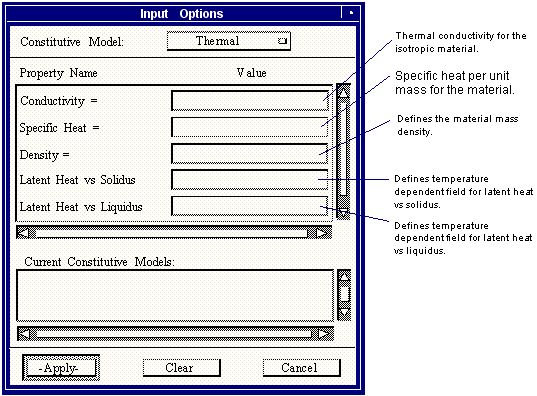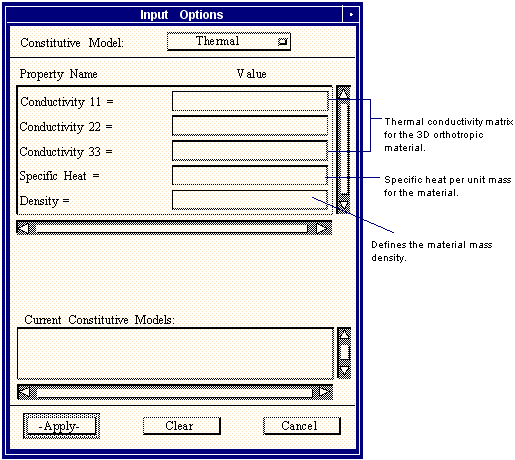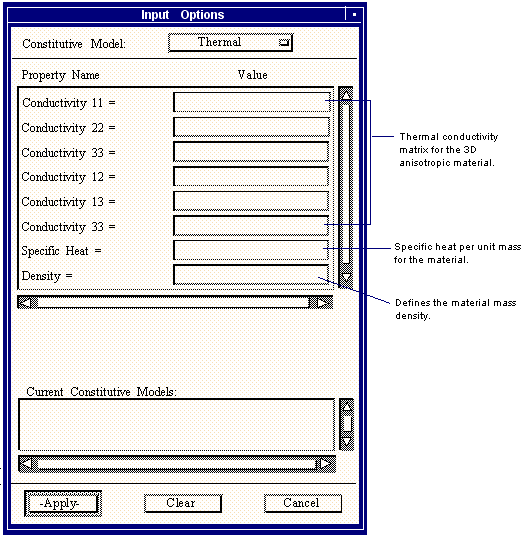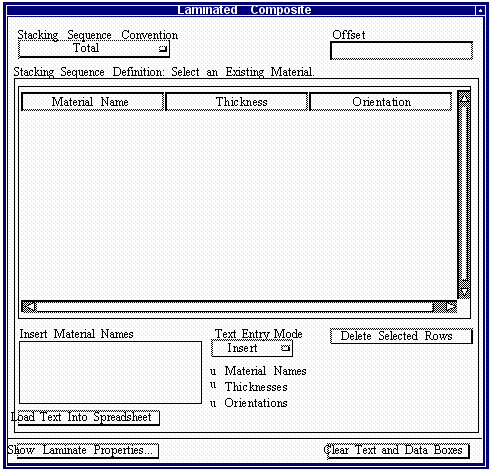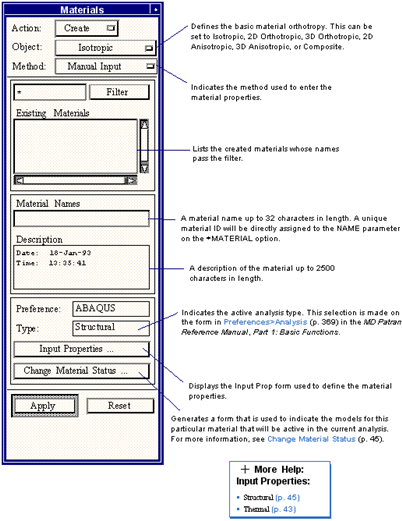

Object | Option 1 | Option 2 | Option 3 |
Isotropic | • Elastic | Material Failure Theory | |
Hyperelastic | Incompressible | Test Data • Ogden • Polynomial Coefficients • Ogden • Neo Hookean • Polynomial | |
Slightly Compressible | Test Data • Ogden • Polynomial Coefficients • Ogden | ||
Compressible | Test Data • Ogden Coefficients • Ogden | ||
Viscoelastic | Frequency | • Formula • Tabular | |
Time | • Prony • Creep Test Data • Combined Creep Test Data • Combined Relax Test Data | ||
• Deformation Plasticity | |||
Plastic | Mises/Hill | ||
Compression Tension Shear | |||
Modified D-Prager/Cap | Cap Hardening | ||
Creep | • Time • Strain | ||
2D Orthotropic (Lamina) | • Elastic | Material Failure Theory | |
Viscoelastic | Frequency | • Formula Tabular | |
Time | • Prony | ||
Plastic | Mises/Hill | ||
Compression Tension Shear | |||
Modified D-Prager/Cap | Cap Hardening | ||
Creep | • Time • Strain | ||
3D Orthotropic | • Elastic | Engineering Constants • [D] Matrix | Material Failure Theory |
Viscoelastic | Frequency | ||
Time | • Prony | ||
Plastic | Mises/Hill | ||
Compression Tension Shear | |||
Modified D-Prager/Cap | Cap Hardening | ||
Creep | • Time • Strain | ||
3D Anisotropic | • Elastic | [D] Matrix | Material Failure Theory |
Viscoelastic | Frequency | ||
Time | • Prony | ||
Plastic | Mises/Hill | ||
Compression Tension Shear | |||
Modified D-Prager/Cap | Cap Hardening | ||
Creep | • Time • Strain | ||
Composite | • Laminate Rule of Mixtures HAL Cont. Fiber HAL Disc. Fiber HAL Cont. Ribbon HAL Disc. Ribbon HAL Particulate Short Fiber 1D Short Fiber 2D |
Object | Option 1 |
Thermal | |
Thermal | |
Composite | Rule of Mixtures HAL Cont. Fiber HAL Disc. Fiber HAL Cont. Ribbon HAL Disc. Ribbon HAL Particulate Short Fiber 1D Short Fiber 2D |
Object | Option 1 | Option 2 |
Isotropic | Elastic | Material Failure Theory |
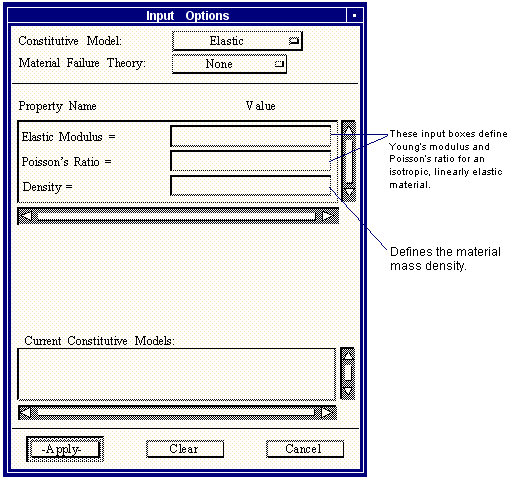
Property Name | Description |
Reference Temperature | This is the reference value of temperature for the coefficient of thermal expansion. The thermal strain in the material is based on the difference between the current temperature and this reference value (default is 0.0). |
Thermal Expansion Coeff | Coefficient of thermal expansion for the isotropic material. |
Fraction Critical Damping | Set this parameter equal to the fraction of critical damping to be used with this material in calculating composite damping factors for the modes (for use in modal dynamics). The default is 0.0. The value is ignored in direct integration dynamics. |
Mass Propornl Damping | Factor for mass proportional damping in direct integration dynamics (default = 0.0). This value is ignored in modal dynamics. |
Stiffness Propornl Damping | Factor for stiffness proportional damping in direct integration dynamics (default = 0.0). This value is ignored in modal dynamics. |
Object | Option 1 | Option 2 | Option 3 |
Isotropic | Hyperelastic | Incompressible | Test Data - Ogden Polynomial |
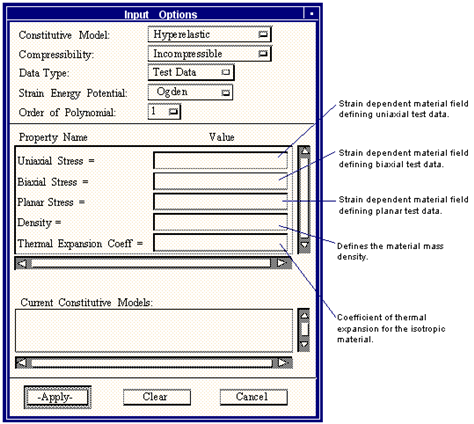
Object | Option 1 | Option 2 | Option 3 |
Isotropic | Hyperelastic | Incompressible | Coefficients - Ogden |
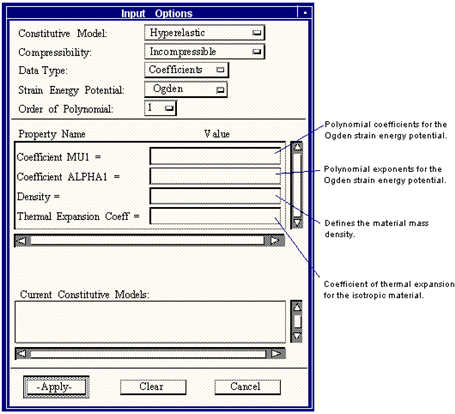
Object | Option 1 | Option 2 | Option 3 |
Isotropic | Hyperelastic | Incompressible | Coefficients - Moony Rivlin Neo Hookean Polynomial |
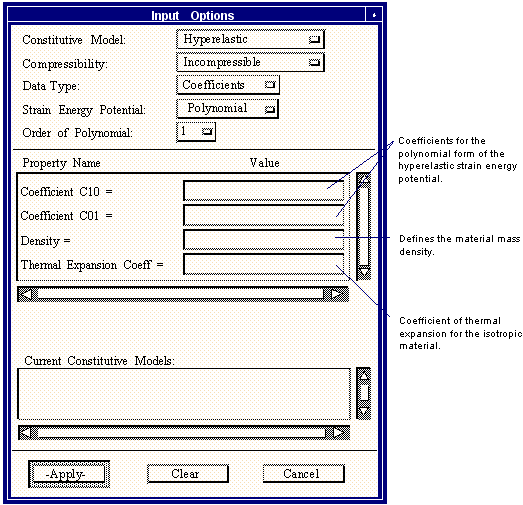
Object | Option 1 | Option 2 | Option 3 |
Isotropic | Hyperelastic | Slightly Compressible | Test Data - Ogden Polynomial |
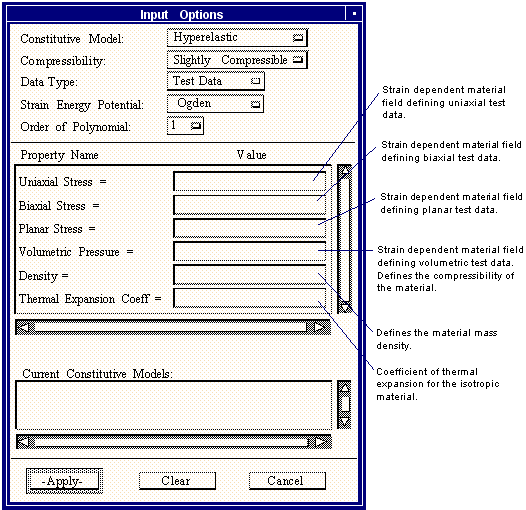
Object | Option 1 | Option 2 | Option 3 |
Isotropic | Hyperelastic | Slightly Compressible | Coefficients - Ogden |
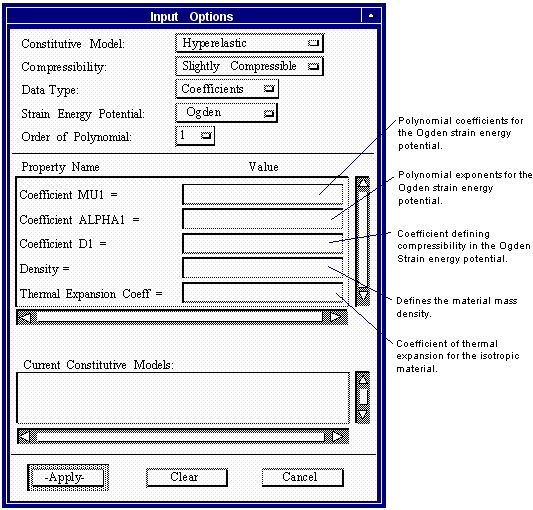
Object | Option 1 | Option 2 | Option 3 |
Isotropic | Hyperelastic | Slightly Compressible | Coefficients - Polynomial |
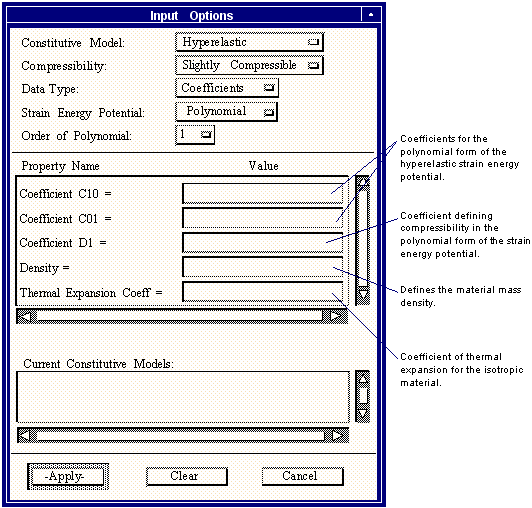
Object | Option 1 | Option 2 | Option 3 |
Isotropic | Hyperelastic | Compressible | Test Data - Ogden |
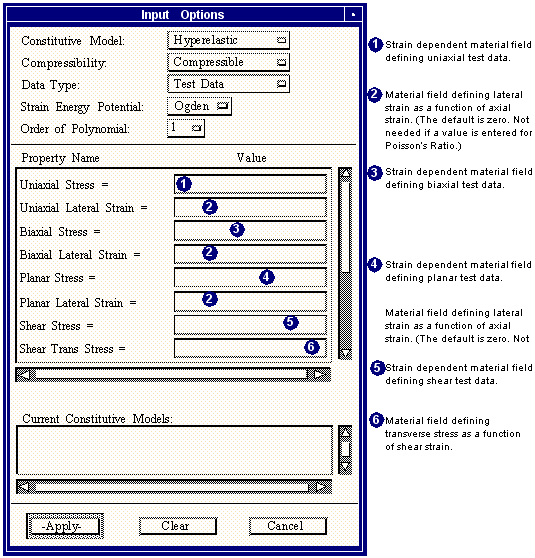
Property Name | Description |
Volumetric Pressure | Material field defining volume ratio (current volume/original volume) as a function of pressure. This field appears on the *VOLUMETRIC TEST DATA sub option. |
Poisson’s Ratio | Effective Poisson’s ratio of the material which will be equal to all |
Density | Defines the material mass density. This quantity appears on the *DENSITY option. |
Thermal Expansion Coeff | Coefficient of thermal expansion for the isotropic material. This parameter appears as a on the *EXPANSION option. |
Object | Option 1 | Option 2 | Option 3 |
Isotropic | Hyperelastic | Compressible | Coefficients - Ogden |
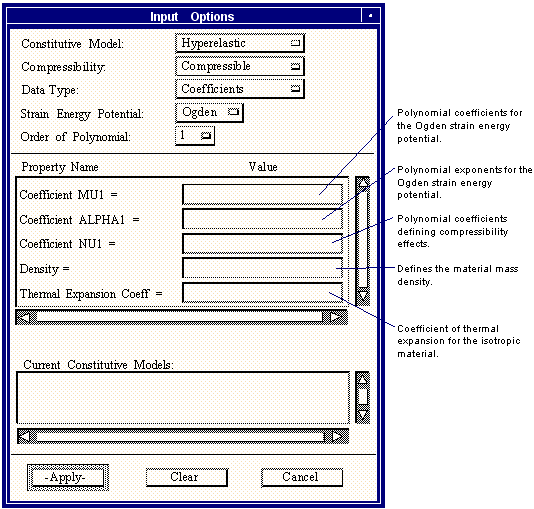
Object | Option 1 | Option 2 | Option 3 |
Isotropic, 2D Orthotropic, 3D Orthotropic or 3D Anisotropic | Viscoelastic | Frequency | Tabular Formula |
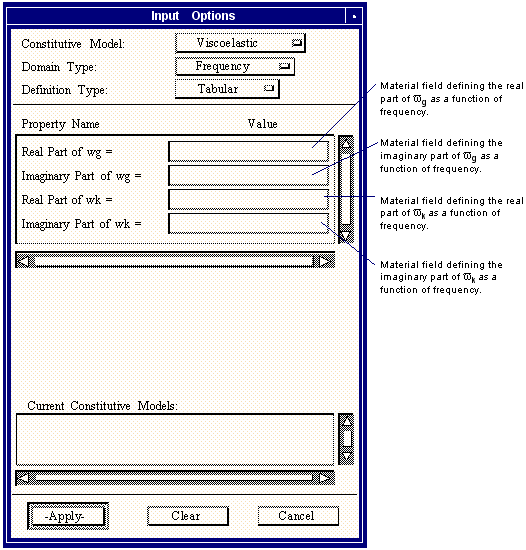
Object | Option 1 | Option 2 | Option 3 |
Isotropic, 2D Orthotropic, 3D Orthotropic or 3D Anisotropic | Viscoelastic | Time | Prony |
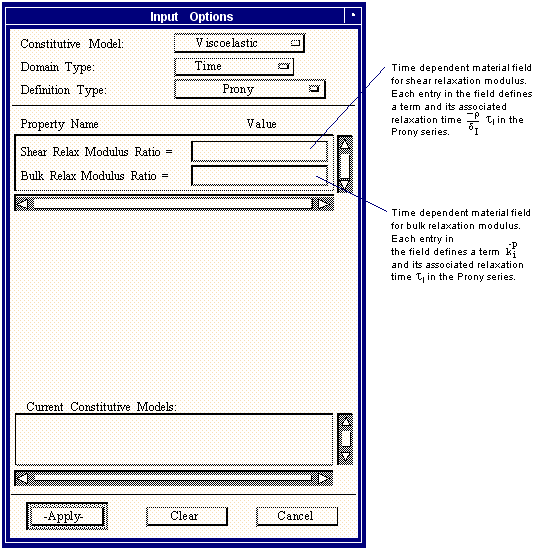
Object | Option 1 | Option 2 | Option 3 |
Isotropic, 2D Orthotropic, 3D Orthotropic or 3D Anisotropic | Viscoelastic | Time | Creep Test Data Combined Creep Test Data |
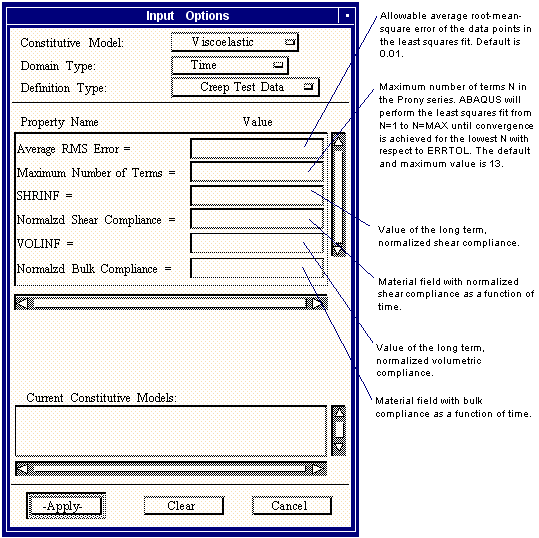
Object | Option 1 | Option 2 | Option 3 |
Isotropic, 2D Orthotropic, 3D Orthotropic or 3D Anisotropic | Viscoelastic | Time | Relaxation Test Data Combined Relax Test Data |
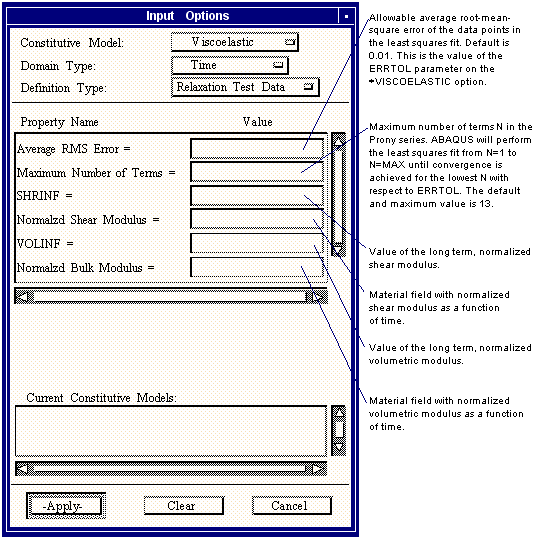
Object | Option 1 |
Isotropic | Deformation Plasticity |
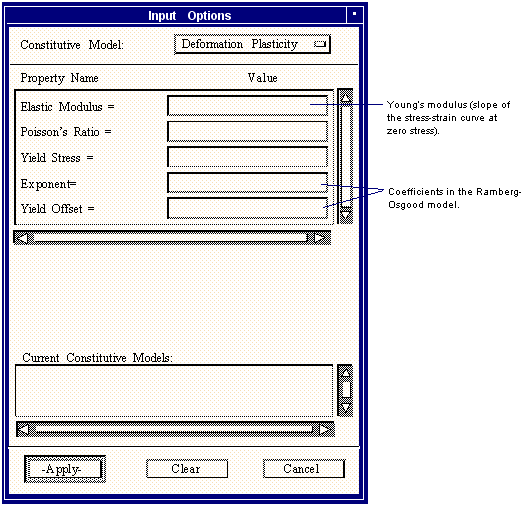
Object | Option 1 | Option 2 | Option 3 |
Isotropic, 2D Orthotropic, 3D Orthotropic or 3D Anisotropic | Plastic | Mises/Hill | Perfect Plasticity |
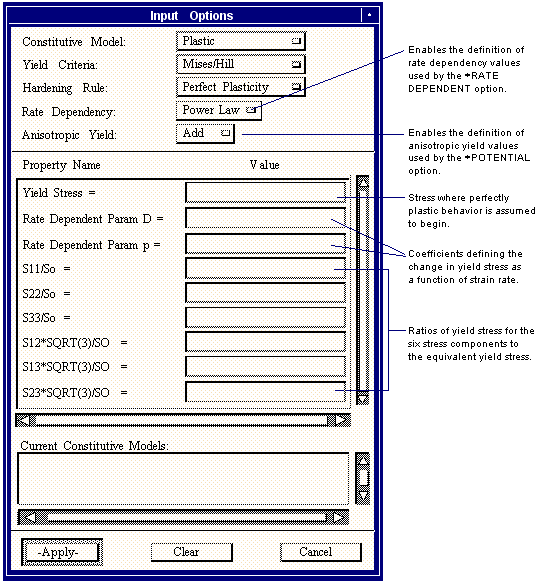
Object | Option 1 | Option 2 | Option 3 |
Isotropic, 2DOrthotropic, 3DOrthotropic or 3D Anisotropic | Plastic | Mises/Hill | Isotropic |
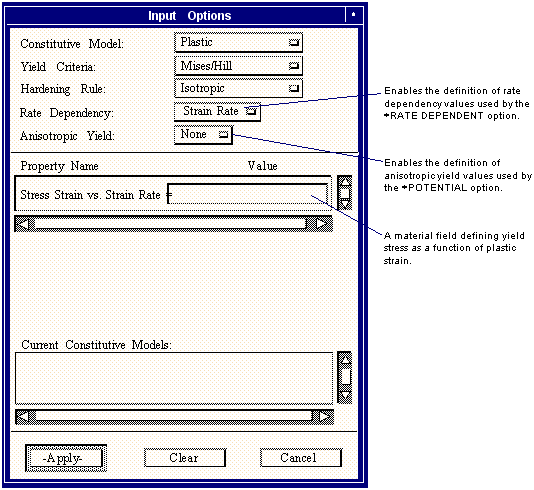
Object | Option 1 | Option 2 | Option 3 |
Isotropic, 2D Orthotropic, 3DOrthotropic or 3D Anisotropic | Plastic | Mises/Hill | Kinematic |
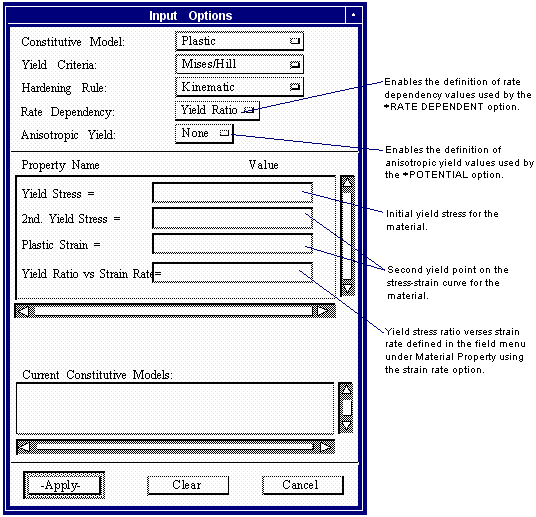
Object | Option 1 | Option 2 | Option 3 |
Isotropic, 2D Orthotropic, 3D Orthotropic or 3D Anisotropic | Plastic | Drucker-Prager | Compression Tension Shear |
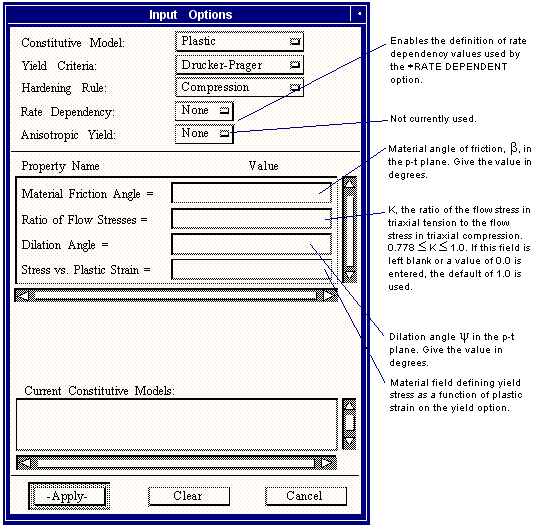
Object | Option 1 | Option 2 | Option 3 |
Isotropic, 2D Orthotropic, 3D Orthotropic or 3D Anisotropic | Plastic | Modified D-Prager/Cap | Cap Hardening |
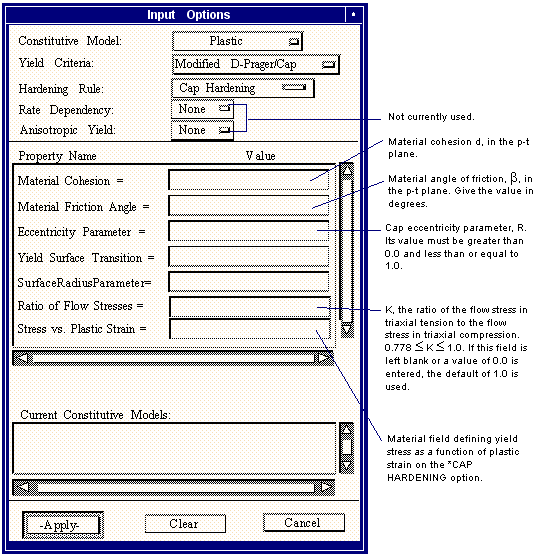
Object | Option 1 | Option 2 |
Isotropic, 2D Orthotropic, 3D Orthotropic or 3D Anisotropic | Creep | Time Strain |
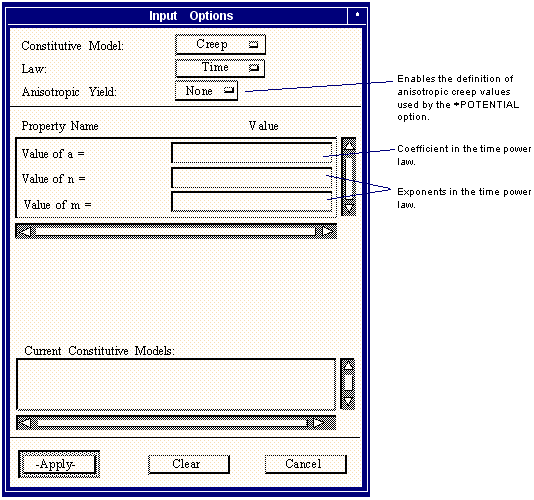
Object | Option 1 | Option 2 |
Isotropic, 2D Orthotropic, 3D Orthotropic or 3D Anisotropic | Creep | Hyperbolic |
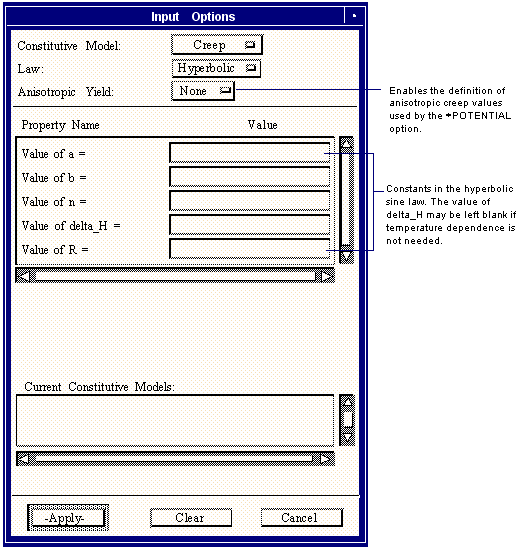
Option 1 | Option 2 |
Elastic | Material Failure Theory |
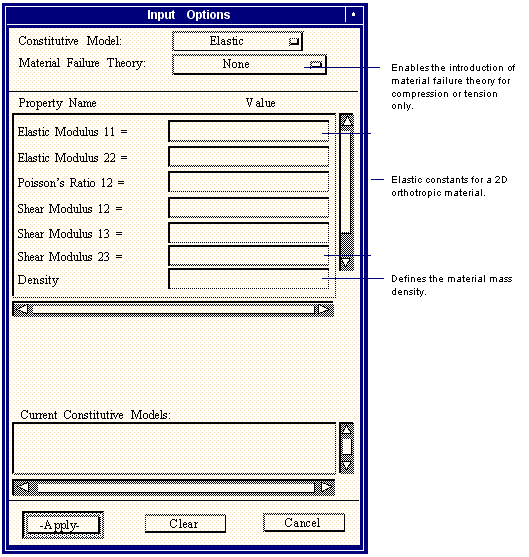
Option 1 | Option 2 | Option 3 |
Elastic | Engineering Constants | Material Failure Theory |
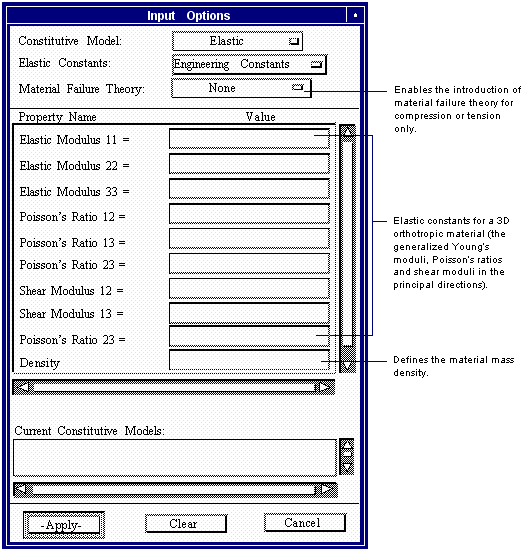
Object | Option 1 | Option 2 | Option 3 |
3D Orthotropic | Elastic | [D] Matrix | Material Failure Theory |
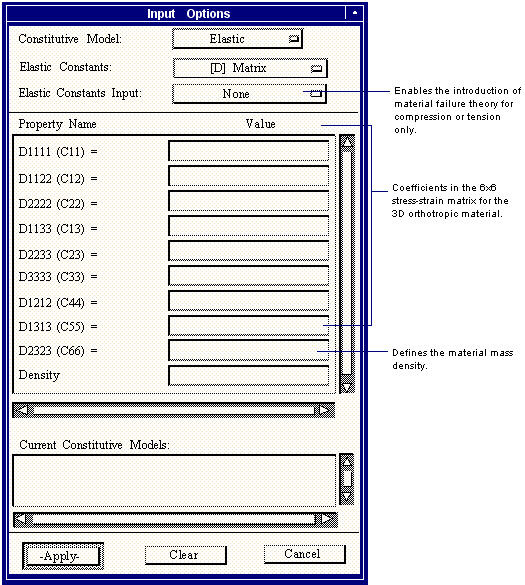
Option 1 | Option 2 |
Elastic | [D] Matrix |
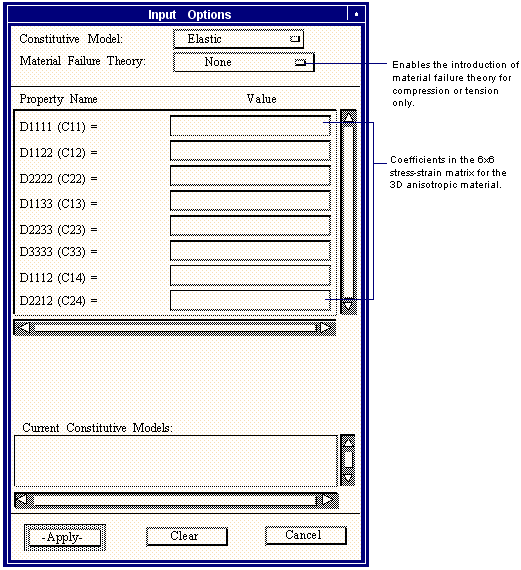
Property Name | Desciption |
D1212 (C34) D1212 (C44) D1113 (C15) D2213 (C25) D3313 (C35) D1213 (C45) D1313 (C55) D1123 (C16) D2223 (C26) D3323 (C36) D1223 (C46) D1323 (C56) D2323 (C66) | Coefficients in the 6 x 6 stress-strain matrix for the 3D anisotropic material. |
Density | Defines the material mass density. |
